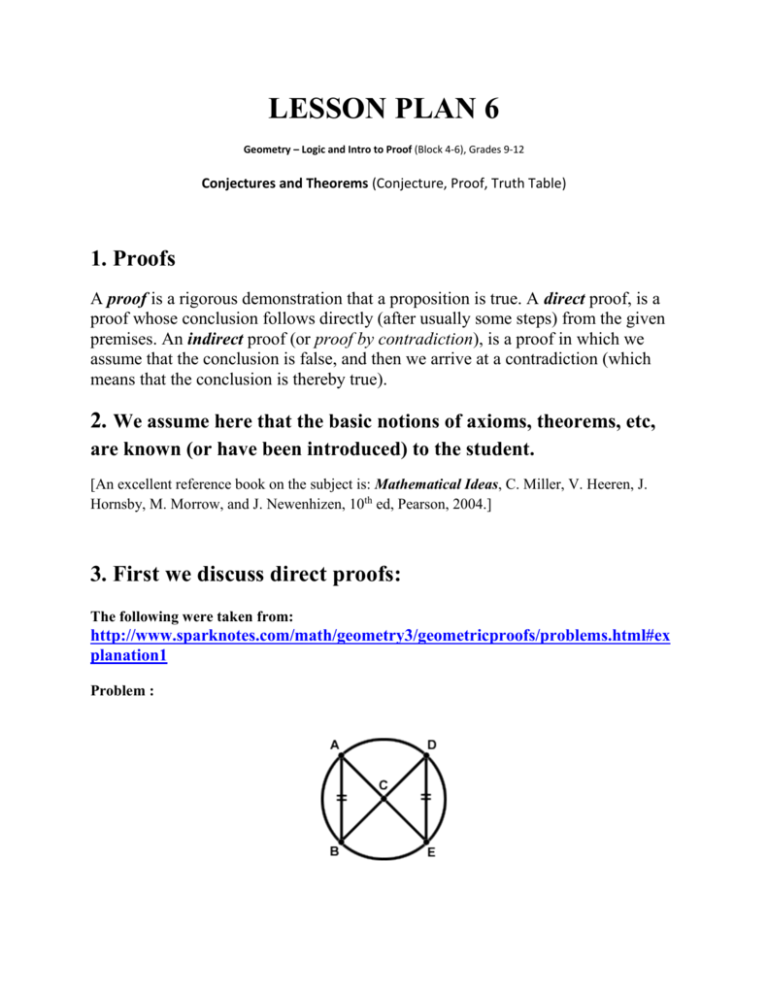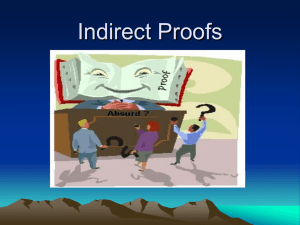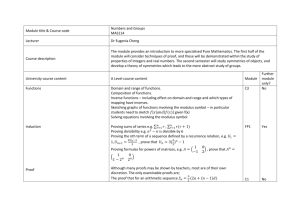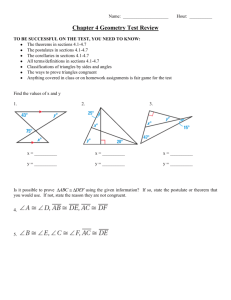Geometry – Logic and Intro to Proof (Block 4-6) - Math GR. 9-12
advertisement

LESSON PLAN 6 Geometry – Logic and Intro to Proof (Block 4-6), Grades 9-12 Conjectures and Theorems (Conjecture, Proof, Truth Table) 1. Proofs A proof is a rigorous demonstration that a proposition is true. A direct proof, is a proof whose conclusion follows directly (after usually some steps) from the given premises. An indirect proof (or proof by contradiction), is a proof in which we assume that the conclusion is false, and then we arrive at a contradiction (which means that the conclusion is thereby true). 2. We assume here that the basic notions of axioms, theorems, etc, are known (or have been introduced) to the student. [An excellent reference book on the subject is: Mathematical Ideas, C. Miller, V. Heeren, J. Hornsby, M. Morrow, and J. Newenhizen, 10th ed, Pearson, 2004.] 3. First we discuss direct proofs: The following were taken from: http://www.sparknotes.com/math/geometry3/geometricproofs/problems.html#ex planation1 Problem : Given: Circle C with triangles ABC and DEC. Chord AB is congruent to chord DE. Prove: Triangles ABC and DEC are congruent. Solution 4. Now we discuss indirect proofs: The following were taken from: http://regentsprep.org/Regents/mathb/1e/indirectlesson.htm When trying to prove a statement is true, it may be beneficial to ask yourself, "What if this statement was not true?" and examine what happens. This is the premise of the Indirect Proof or Proof by Contradiction. Indirect Proof: Assume what you need to prove is false, and then show that something contradictory (absurd) happens. Steps in an Indirect Proof: Assume that the opposite of what you are trying to prove is true. From this assumption, see what conclusions can be drawn. These conclusions must be based upon the assumption and the use of valid statements. Search for a conclusion that you know is false because it contradicts given or known information. Oftentimes you will be contradicting a piece of GIVEN information. Since your assumption leads to a false conclusion, the assumption must be false. If the assumption (which is the opposite of what you are trying to prove) is false, then you will know that what you are trying to prove must be true. How to Recognize When an Indirect Proof is Needed: Proof by Contradiction is also known as reductio ad absurdum (which from Latin means reduced to an absurdity). Generally, the word "not" or the presence of a "not symbol" (such as the not equal sign ) in a problem indicates a need for an Indirect Proof. Example: (done in a two-column format) In the accompanying diagram, is not isosceles. Prove that if altitude is drawn, it will not bisect . In this example, we must first clearly indicate the GIVEN and the PROVE. Given: Prove: STATEMENTS 1. REASONS 1. Given 2. Assume (Remember to assume the opposite of the PROVE.) 2. Assumption leading to a contradiction. 3. 3. Bisector of a segment divides the segment at its midpoint. 4. 4. Midpoint divides a segment into two congruent segments. 5. 5. The altitude of a triangle is a line segment extending from any vertex of a triangle perpendicular to the line containing the opposite side. 6. 6. Perpendicular lines meet to form right angles. 7. 7. All right angles are congruent. 8. 8. Reflexive Property 9. 9. SAS 10. 10. CPCTC 11. 11. An isosceles triangle is a triangle with two congruent sides. 12. 12. Contradiction steps 1 and 11 Practice online here: http://regentsprep.org/Regents/mathb/1c/preprooftriangles.htm http://regentsprep.org/Regents/mathb/1e/indirectpractice.htm Activity: http://regentsprep.org/Regents/mathb/1e/indirectteacher.htm Worksheets: http://www.math.hawaii.edu/~woolcutt/2007_summer_100/homework_04.pdf http://www.franklinroadacademy.com/teachers/zab/Geometry%28H%29/worksheets/Workshe etTruthTableII.pdf 4. Linked Videos: More proofs are presented in the following videos: http://www.youtube.com/watch?v=vsluxs0B9Gg&feature=related http://www.youtube.com/watch?v=zQ6Y0fismDg&feature=related http://www.youtube.com/watch?v=b0SItpVQeqI





